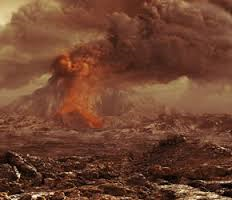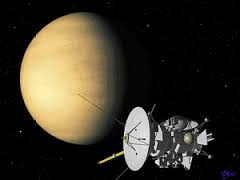Overview
The planet Venus is the second planet from the sun in the Solar System. It is one of the four terrestrial planets, with a dense, thick atmosphere and a rocky body. It is nearly the size of the planet Earth. Since it is closer to the sun, its year takes a little over 224 days on Earth.
The Atmosphere of Venus
The atmosphere of the planet Venus covers the planet completely with thick clouds. Over 96 percent of it is made up of carbon dioxide, with some nitrogen, and trace amounts of sulfur dioxide, argon, carbon monoxide, water vapor, helium, and neon. It is so dense and thick that the atmospheric pressure is like the pressure at a depth of over 90 meters beneath the surface of the ocean on Planet Earth. The thickest part of the atmosphere (the troposphere) is nearest to the surface. At about 50 to 55 km above the surface, the atmosphere thins. However, it is not hospitable, as opaque clouds on Venus are made mostly of sulfuric acid and sulfur dioxide. Those compounds are probably made in the upper atmosphere, from ultraviolet light breaking up trace amounts of carbon dioxide and sulfur dioxide.
The Winds of Venus
The atmosphere is so thick near the planet’s surface that almost no wind blows there. As the atmosphere thins, the winds increase, and actually move faster than Venus rotates, at about 360 km/h (220 mph). Huge hurricanes and cyclones are located above the poles of the planet. With all the wind movement and convection currents, the atmosphere circulates very frequently.
The Surface of Venus
The greenhouse effect from the dense, thick atmosphere heats the surface to over 460°C (863°F), so that it is actually hotter than the surface of Mercury. No free water exists on the planet, although liquid carbon dioxide may have once formed seas under pressure. The landscape consists of smooth volcanic plains, with some lava plateaus and two larger highland regions. Thousands of volcanic mountains are all over the planet, and many are still active. There are several large mountain ranges, one with mountains seven miles (11.3 km) high.
Observations of Venus
The ancients knew Venus as a bright star in the sky; a morning star named Lucifer and an evening star named Vesper. Galileo observed the phases of Venus with his telescope in the early 17th century, and the atmosphere was first noticed in the late 18th century. The most successful observations of the planet have been carried out by a number of space probes, including the Venera series from Russia in the 1960’s, 1970’s, and 1980’s; the US Mariner and Pioneer series in the 1970’s; orbital flights; and several future missions. Harsh conditions on Venus have meant that many spacecraft have been lost, and others have stopped transmitting.
Interested in science tutoring services? Learn more about how we are assisting thousands of students each academic year.
SchoolTutoring Academy is the premier educational services company for K-12 and college students. We offer tutoring programs for students in K-12, AP classes, and college. To learn more about how we help parents and students in Flint, MI: visit Tutoring in Flint, MI




